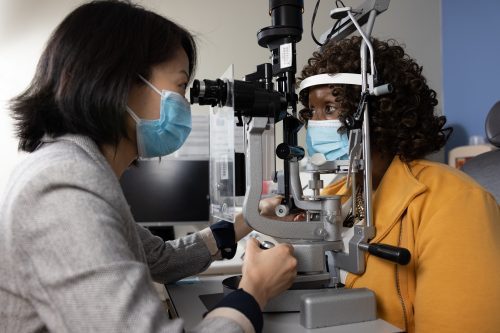Eye strain and headaches can be symptoms of too much screen time. But these also can be the first signs that you need a new glasses prescription, according to optometrist Haley Italia, OD.
Wincing and straining your eyes staring at a screen all day? You may think you’re just getting too much screen time, as many have throughout the pandemic due to increased working from home. However, these symptoms might actually be a signal to call your optometrist to get your vision checked.
“If a patient comes in and tells me they have a lot of eye strain at the computer, first things first, is I check their glasses prescription,” Haley Italia, OD, an optometrist at Mass Eye and Ear, told Focus.
Dr. Italia answered some questions to help determine whether it’s time for a new prescription and offered some tips to reduce strain from too much screen time.
How is screen time related to needing a new prescription?
I often tell my patients that a very small change in a glasses prescription is going to be most noticeable when spending hours in front of a computer screen or while night driving. That’s because those are two of the most visually demanding tasks we do in our day. Many people are surprised that a slight change in prescription can be so noticeable.

What are some signs you might need a new prescription?
A patient might present with complaints of eye strain or strange headaches. Some might complain of blurry vision, but often the signs are more subtle. A person might find their eyes are more fatigued earlier in the day than they used to be, or feel a little tension on the sides of the eyes.
Regarding night driving, a patient might see “starbursting,” or when the glare off headlight projects bright circles and looks streaky.
These are signs it might be time to get your prescription checked.
What causes a prescription to change?
There are many reasons why a prescription can change. For one, the eyes grow just like the rest of our bodies, and that can result in a prescription change in younger adults. Previously it was thought the eyes stopped growing once a person’s growth stopped; however, research has shown the eyes can grow beyond that throughout a person’s twenties. I’ll often see patients in graduate school whose prescriptions have changed.
In older adults, age-related changes to the eye’s natural lens and cornea can lead to a prescription change.. The cornea can change shape as we get older, or a person can develop astigmatism, which can result in the need for a new prescription.
Do screens themselves actually change the prescription?
There is some debate in the vision community; but for the most part, there is no concrete evidence that suggests screen time itself will change a person’s prescription. One thing to note is that studies have found people who spend more time outdoors — and therefore put less visual demand on their eyes — have slower progression of near-sightedness. Anecdotally, I’ve seen similar phenomena in my graduate school patients; they become increasingly nearsighted as they spend more time studying or in front of computers, and once grad school ends, their prescription stabilizes.
How does the strain from staring at a computer differ from needing a new prescription?
I’ve seen a big increase in patients coming in complaining about issues related to screen time. Or, they’ll come to me with symptoms of burning and excessive tearing in their eyes which are classic dry eye symptoms that can result from too much screen time.
One thing I recommend to all patients is the 20-20-20 rule. For every 20 minutes of screen time, try to look 20 feet away for 20 seconds. This simple rule helps to reset the focusing system of our eyes, so a person does not get locked into over-focusing, and importantly, it allows us to blink. When we are doing any near work that requires a lot of concentration, we blink less frequently; with computer use in particular, our eyes are straight ahead and wide open and more likely to get dried out.
Also, when we do blink while on the computer, we tend to do this half blink where the top lid does not fully touch the bottom. That action is actually really important in expressing oil glands in our eyelids, and without that, all the oil that helps lubricate the surface of the eyes doesn’t get expressed and the eyes dry out much faster. During those 20 seconds of looking far away, I encourage my patients to do full, complete blinks.
Those 20-20-20 breaks on their own will help a lot of the symptoms due to eye strain.
Can other problems cause difficulty while using screens?
Not only could eye strain and headaches be a prescription issue, there could be issues with the ways the eyes work together. For instance, the eyes need to converge to look at a computer screen, and some people have a harder time doing that than others. There might also be issues with the ocular surface contributing to these symptoms. The bottom line is a person experiencing any strain and symptoms should see an optometrist or ophthalmologist for a full visit, as they can help tease out what is happening.
How often should you get your vision checked?
If someone is in early adulthood and hasn’t had an eye exam since childhood, definitely come in and get a good baseline exam. After that, if they require a glasses prescription, I recommend they come back at least every two years. A glasses prescription typically expires two years after its written, which means you can’t get it filled if they break.
Even if that prescription stays the same, the lens itself can get very scratched or the coating can wear off, and having a poor optical quality is going to give you more eye strain and fatigue. Having a scratched or dirty lens will cause your eye to focus on that grime rather than the screen.
If a person does not need glasses and does not have any other eye health concerns, I recommend a complete dilated eye exam every two to five years.
As people get older such as age 50 and up, I recommend a full exam each year. The health in the back of the eye and eye’s surface can change with age, therefore a full exam with dilation can help rule out anything else other than a changing glasses prescription.
About our expert
 Haley Italia, OD, is a member of the Optometry Service who offers comprehensive eye examinations. Dr. Italia sees patients at our Assembly Row, Malden and 243 Charles St., Boston, locations.
Haley Italia, OD, is a member of the Optometry Service who offers comprehensive eye examinations. Dr. Italia sees patients at our Assembly Row, Malden and 243 Charles St., Boston, locations.

good